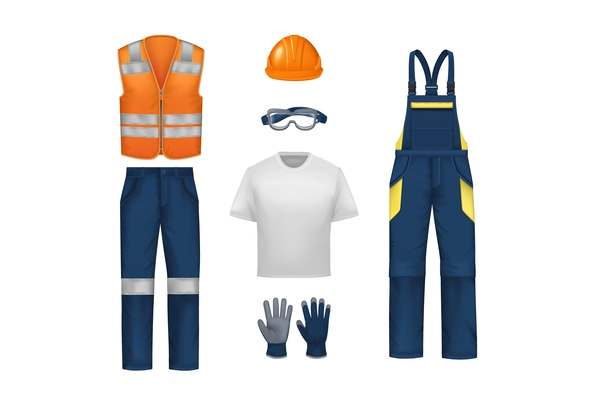8 Things To Know About High Visibility Workwear
High visibility Workwear, often referred to as hi-vis clothing, is an essential component of workplace safety in various industries. Whether you work in construction, road maintenance, or any occupation where visibility is a critical concern, understanding the key aspects of high-visibility workwear is vital. This article explores eight important things to know about high-visibility workwear, highlighting its significance, components, and how to select the right gear to enhance safety on the job.
1. The Importance of High Visibility Workwear
High visibility workwear is designed to do exactly what its name suggests: make workers highly visible. This is crucial in scenarios where employees are exposed to potential hazards, such as moving vehicles or heavy machinery. Wearing high-visibility workwear significantly reduces the risk of accidents by enhancing the visibility of workers in various conditions, including low light, inclement weather, and heavy traffic.
2. Key Components of High Visibility Workwear
High-visibility workwear typically consists of three key components:
a). Fluorescent Material
The fabric is often bright yellow or orange, as these colors are most effective at catching the eye. The fluorescent material helps the wearer stand out against their surroundings, even in low light conditions.
b). Retro-Reflective Tape
Sewn onto the clothing, retro-reflective tape reflects light back towards its source, which is especially important during nighttime work or when headlights are directed towards the worker.
c). Background Material
This covers the majority of the garment and is responsible for enhancing the overall visibility and contrast.
3. Different Classes of High Visibility Workwear
High visibility workwear is categorized into three classes, each with specific requirements and intended uses:
a. Class 1: For workers in low-risk environments where the highest level of visibility is not necessary, such as warehouse personnel.
b. Class 2: Designed for moderate-risk settings, such as roadside construction or parking lot attendants.
c. Class 3: Reserved for high-risk environments like highway construction and emergency personnel, where maximum visibility is essential.
4. Material Selection
High-visibility workwear is available in various materials, including mesh, cotton, polyester, and more. When choosing the right material, consider the job's demands, climate, and comfort. Mesh options are great for breathability, while waterproof materials might be necessary for outdoor work in wet conditions.
5. Maintenance and Care
High-visibility workwear requires proper care to maintain its effectiveness. Regularly inspect your clothing for wear and tear, including damaged retro-reflective tape. Follow the manufacturer's care instructions to ensure the longevity of your high-visibility gear. Regular washing, ideally using non-detergent, will also help maintain the clothing's visibility.
6. Layering for Comfort and Visibility
In colder climates, the use of high-visibility workwear becomes even more critical to ensure the safety and comfort of workers. Layering is a key strategy in addressing the unique challenges posed by inclement weather. When working in suboptimal conditions with fluctuating temperatures, the right combination of layers not only keeps you warm but also maximizes your visibility, allowing you to maintain safety without compromising comfort. High-visibility vests and jackets are invaluable additions to your ensemble in such conditions.
By incorporating hi-vis vests or jackets over your existing workwear, you create an extra layer of insulation against the cold, wind, and precipitation. These outer layers are specifically designed to enhance your visibility while offering protection from the elements. They feature the same fluorescent materials and retro-reflective tape that make high visibility workwear effective in low light, and they ensure that you remain conspicuous even in adverse weather conditions. Whether you're working in snowy, foggy, or rainy environments, these garments act as a protective shield while maintaining your visibility to both colleagues and potential hazards.
7. Accessories and Customization
Beyond clothing, high-visibility accessories such as gloves, hard hats, and belts are available to enhance safety. Some workers may need specialized high-visibility gear to accommodate their unique job requirements. Many suppliers also offer customization options, allowing you to add your company logo or name to your high-visibility workwear.
8. Compliance with Regulations
Regulations regarding high-visibility workwear can vary by country and industry. Ensure that your clothing meets the necessary standards and certifications to remain compliant with safety guidelines. Non-compliance could lead to workplace accidents, fines, or legal liabilities, making it essential to prioritize safety through the use of proper high-visibility workwear.
Unito: Your Ultimate Cross-Functional Collaboration Solution
Unito stands out due to its intuitive interface and versatile features, catering to diverse business needs. Its adaptability allows for a cohesive workflow regardless of the preferred project management tool used by various teams. With Unito, businesses experience enhanced transparency, facilitating a clearer overview of project progress and team contributions.
Furthermore, its customizable settings and real-time synchronization ensure that changes made in one tool reflect seamlessly across all integrated platforms. By simplifying complex workflows and fostering collaboration, Unito becomes the linchpin for successful, streamlined, and agile project management across your organization.
Follow us on:
Facebook | Instagram | LinkedIn | Twitter | Google My Business




